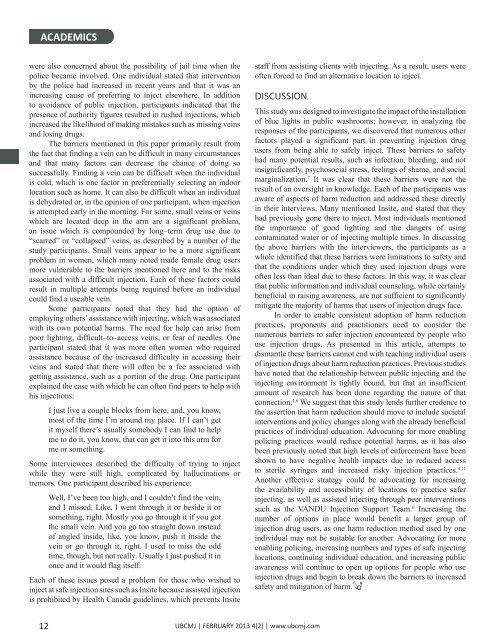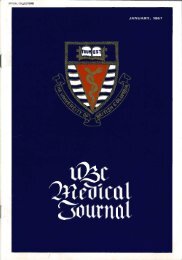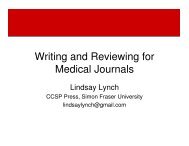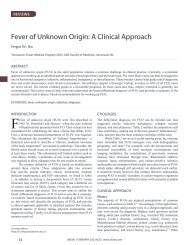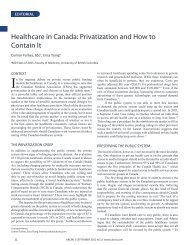Download full PDF - UBC Medical Journal
Download full PDF - UBC Medical Journal
Download full PDF - UBC Medical Journal
Create successful ePaper yourself
Turn your PDF publications into a flip-book with our unique Google optimized e-Paper software.
ACADEMICS<br />
were also concerned about the possibility of jail time when the<br />
police became involved. One individual stated that intervention<br />
by the police had increased in recent years and that it was an<br />
increasing cause of preferring to inject elsewhere. In addition<br />
to avoidance of public injection, participants indicated that the<br />
presence of authority figures resulted in rushed injections, which<br />
increased the likelihood of making mistakes such as missing veins<br />
and losing drugs.<br />
The barriers mentioned in this paper primarily result from<br />
the fact that finding a vein can be difficult in many circumstances<br />
and that many factors can decrease the chance of doing so<br />
success<strong>full</strong>y. Finding a vein can be difficult when the individual<br />
is cold, which is one factor in preferentially selecting an indoor<br />
location such as home. It can also be difficult when an individual<br />
is dehydrated or, in the opinion of one participant, when injection<br />
is attempted early in the morning. For some, small veins or veins<br />
which are located deep in the arm are a significant problem,<br />
an issue which is compounded by long–term drug use due to<br />
“scarred” or “collapsed” veins, as described by a number of the<br />
study participants. Small veins appear to be a more significant<br />
problem in women, which many noted made female drug users<br />
more vulnerable to the barriers mentioned here and to the risks<br />
associated with a difficult injection. Each of these factors could<br />
result in multiple attempts being required before an individual<br />
could find a useable vein.<br />
Some participants noted that they had the option of<br />
employing others’ assistance with injecting, which was associated<br />
with its own potential harms. The need for help can arise from<br />
poor lighting, difficult–to–access veins, or fear of needles. One<br />
participant stated that it was more often women who required<br />
assistance because of the increased difficulty in accessing their<br />
veins and stated that there will often be a fee associated with<br />
getting assistance, such as a portion of the drug. One participant<br />
explained the ease with which he can often find peers to help with<br />
his injections:<br />
I just live a couple blocks from here, and, you know,<br />
most of the time I’m around my place. If I can’t get<br />
it myself there’s usually somebody I can find to help<br />
me to do it, you know, that can get it into this arm for<br />
me or something.<br />
Some interviewees described the difficulty of trying to inject<br />
while they were still high, complicated by hallucinations or<br />
tremors. One participant described his experience:<br />
Well, I’ve been too high, and I couldn’t find the vein,<br />
and I missed. Like, I went through it or beside it or<br />
something, right. Mostly you go through it if you got<br />
the small vein. And you go too straight down instead<br />
of angled inside, like, you know, push it inside the<br />
vein or go through it, right. I used to miss the odd<br />
time, though, but not really. Usually I just pushed it in<br />
once and it would flag itself.<br />
Each of these issues posed a problem for those who wished to<br />
inject at safe injection sites such as Insite because assisted injection<br />
is prohibited by Health Canada guidelines, which prevents Insite<br />
staff from assisting clients with injecting. As a result, users were<br />
often forced to find an alternative location to inject.<br />
DISCUSSION<br />
This study was designed to investigate the impact of the installation<br />
of blue lights in public washrooms; however, in analyzing the<br />
responses of the participants, we discovered that numerous other<br />
factors played a significant part in preventing injection drug<br />
users from being able to safely inject. These barriers to safety<br />
had many potential results, such as infection, bleeding, and not<br />
insignificantly, psychosocial stress, feelings of shame, and social<br />
marginalization. 7 It was clear that these barriers were not the<br />
result of an oversight in knowledge. Each of the participants was<br />
aware of aspects of harm reduction and addressed these directly<br />
in their interviews. Many mentioned Insite, and stated that they<br />
had previously gone there to inject. Most individuals mentioned<br />
the importance of good lighting and the dangers of using<br />
contaminated water or of injecting multiple times. In discussing<br />
the above barriers with the interviewers, the participants as a<br />
whole identified that these barriers were limitations to safety and<br />
that the conditions under which they used injection drugs were<br />
often less than ideal due to these factors. In this way, it was clear<br />
that public information and individual counseling, while certainly<br />
beneficial in raising awareness, are not sufficient to significantly<br />
mitigate the majority of harms that users of injection drugs face.<br />
In order to enable consistent adoption of harm reduction<br />
practices, proponents and practitioners need to consider the<br />
numerous barriers to safer injection encountered by people who<br />
use injection drugs. As presented in this article, attempts to<br />
dismantle these barriers cannot end with teaching individual users<br />
of injection drugs about harm reduction practices. Previous studies<br />
have noted that the relationship between public injecting and the<br />
injecting environment is tightly bound, but that an insufficient<br />
amount of research has been done regarding the nature of that<br />
connection. 4,6 We suggest that this study lends further credence to<br />
the assertion that harm reduction should move to include societal<br />
interventions and policy changes along with the already beneficial<br />
practices of individual education. Advocating for more enabling<br />
policing practices would reduce potential harms, as it has also<br />
been previously noted that high levels of enforcement have been<br />
shown to have negative health impacts due to reduced access<br />
to sterile syringes and increased risky injection practices. 4,11<br />
Another effective strategy could be advocating for increasing<br />
the availability and accessibility of locations to practice safer<br />
injecting, as well as assisted injecting through peer interventions<br />
such as the VANDU Injection Support Team. 6 Increasing the<br />
number of options in place would benefit a larger group of<br />
injection drug users, as one harm reduction method used by one<br />
individual may not be suitable for another. Advocating for more<br />
enabling policing, increasing numbers and types of safe injecting<br />
locations, continuing individual education, and increasing public<br />
awareness will continue to open up options for people who use<br />
injection drugs and begin to break down the barriers to increased<br />
safety and mitigation of harm.<br />
12<br />
<strong>UBC</strong>MJ | FEBRUARY 2013 4(2) | www.ubcmj.com


